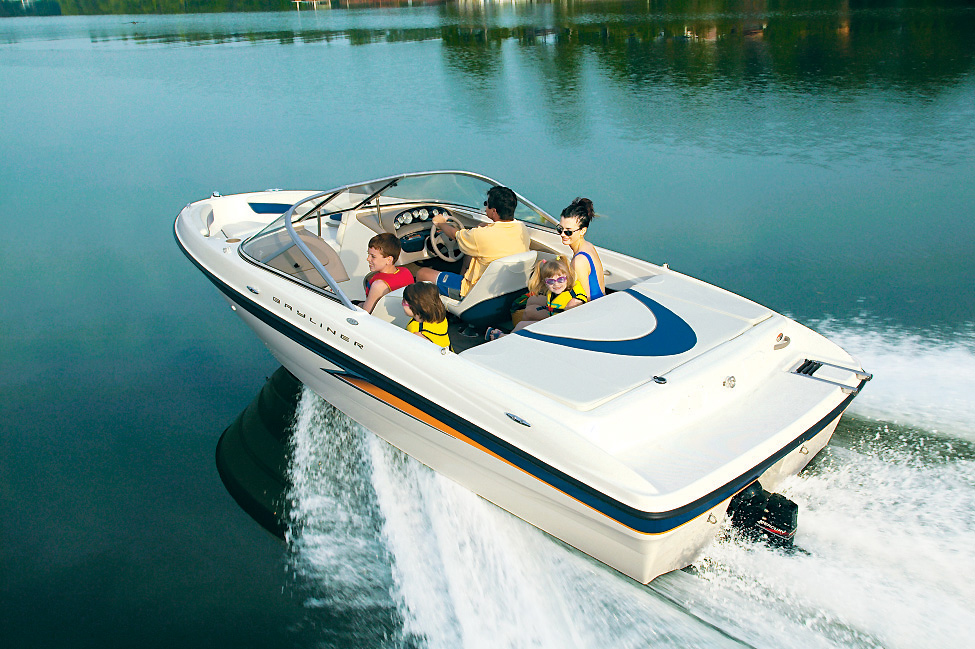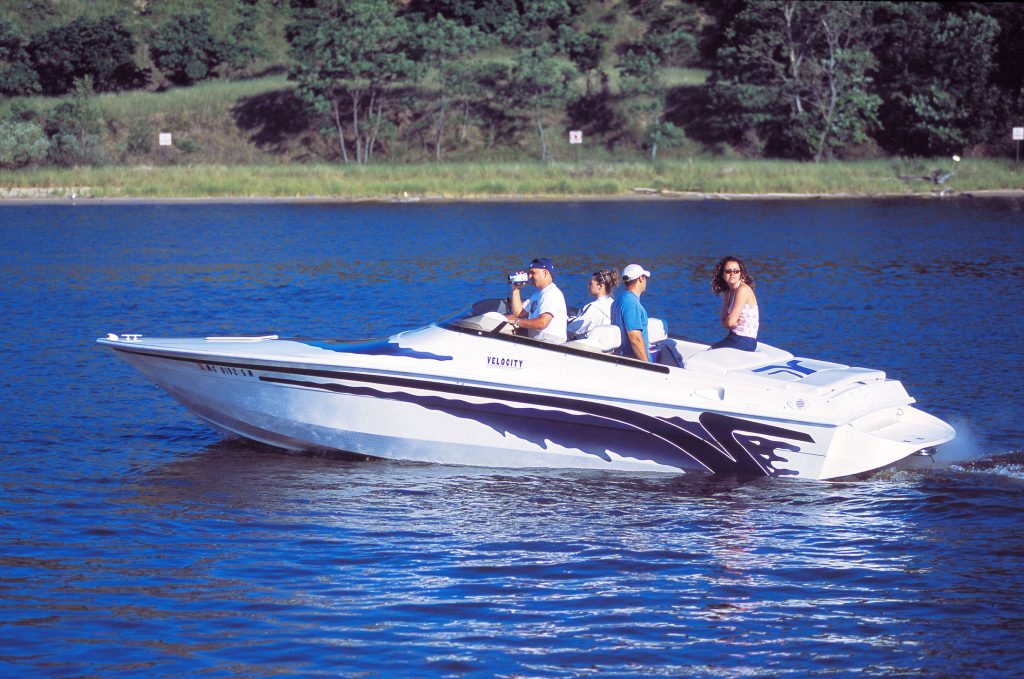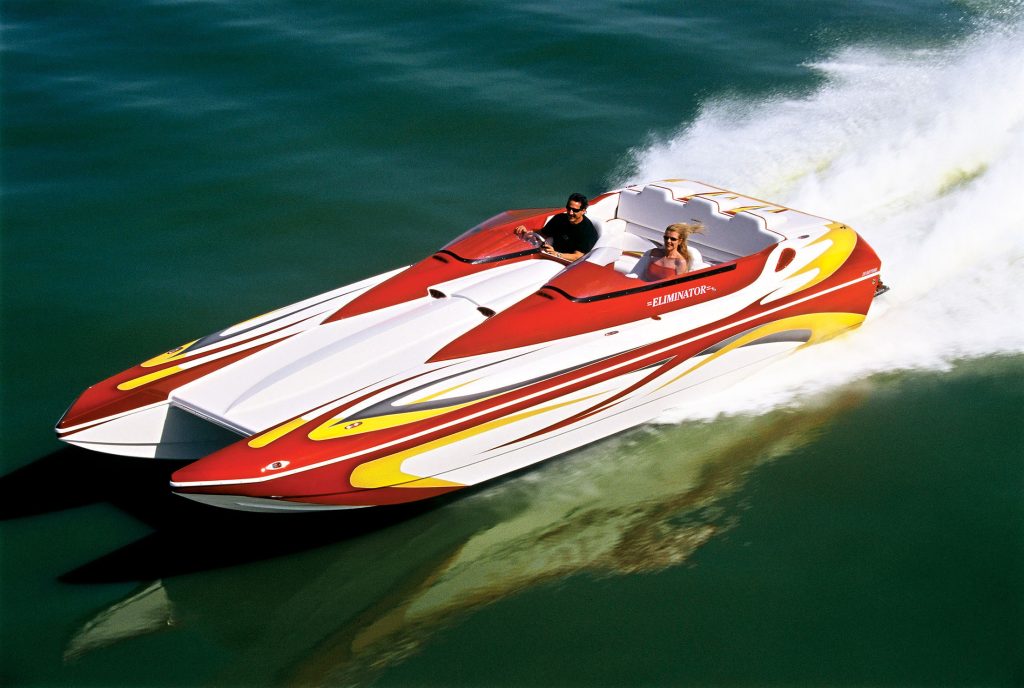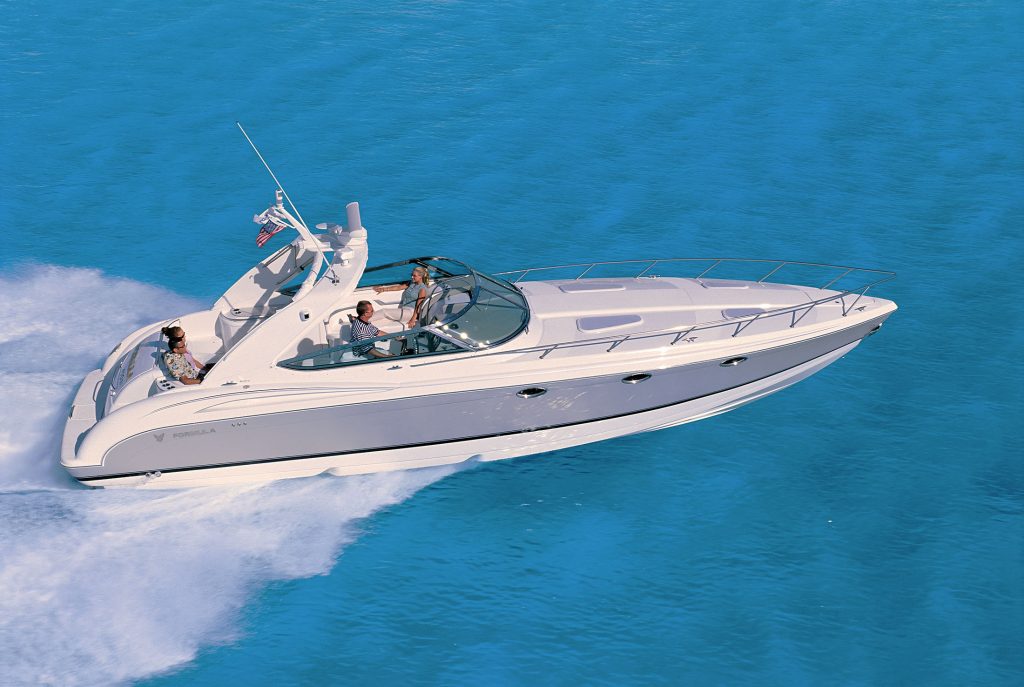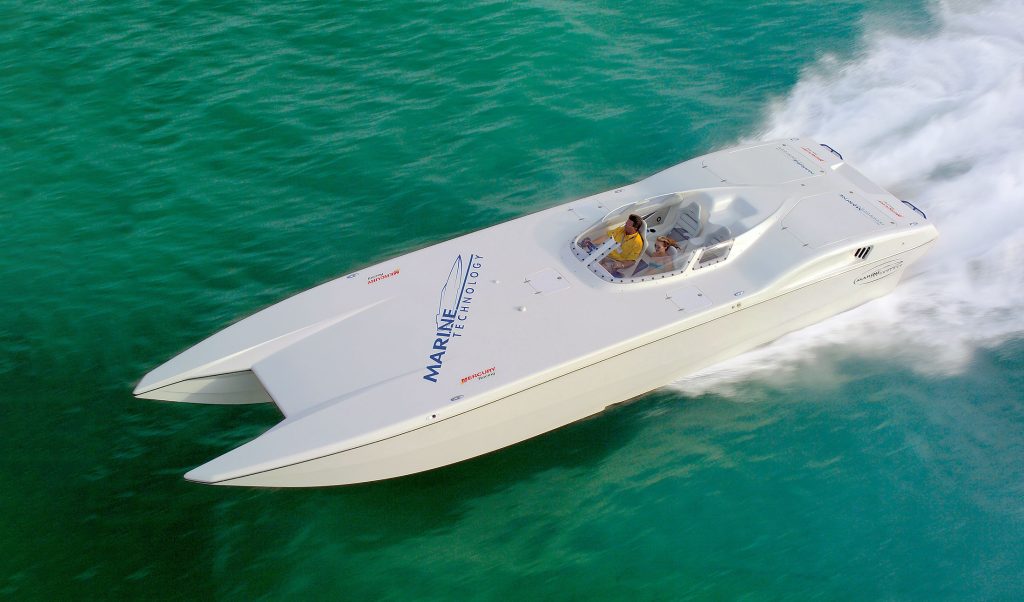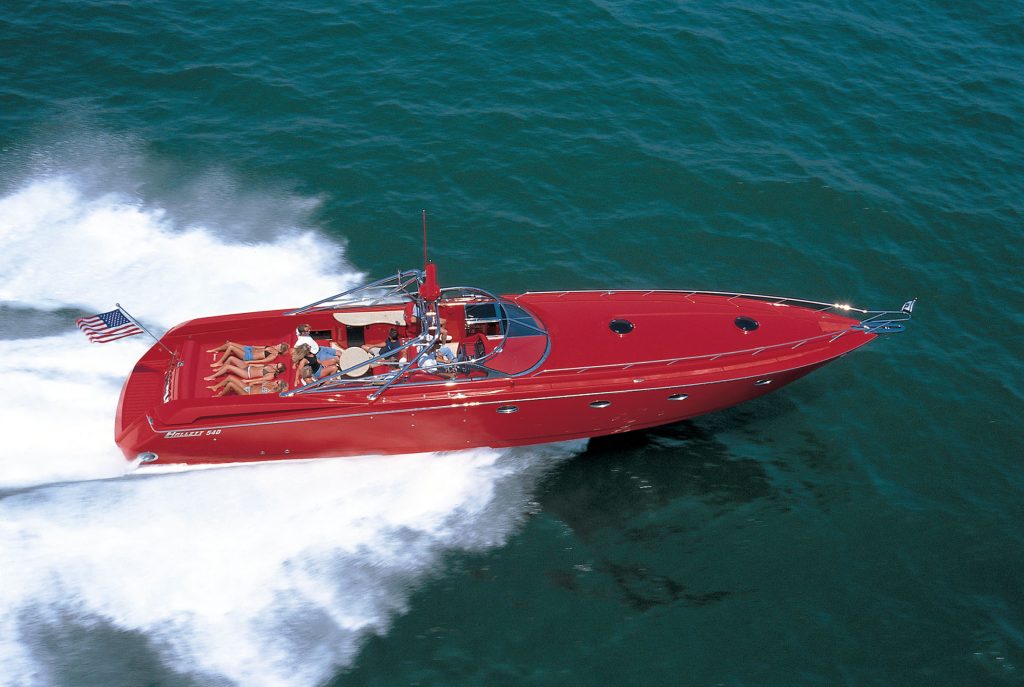PLAYING FAVORITES
From Superboats to Bowriders, Here’s a List of a Few of Our Favorite Boats
Author

Warren Kosikov
It’s one of our favorite pastimes on a rainy day: we sit around and talk about our favorite boat or boats. It could be the first boat you ever drove or even a favorite hot rod you always wished you could have instead of the bowrider or deckboat you use to accommodate your family’s needs. Then, of course, there are the big-time offshore go-fasts that make everybody’s jaws drop.
You know which boats have a special spot in your heart. Let’s see how your list stacks up against ours. Our list is strictly subjective, based on the experiences we’ve had on the water. We broke them down into 5-foot length increments. Some segments have more than others do, and that’s simply because we liked more boats in that size range than in another. You’re starting to get the point. There are no rules, just our opinion. You’ll agree with some and strongly disagree with others, so please send in your pro and con opinions; we’d love to hear your thoughts on such an open subject. Now check out our list.
15 – 20 Foot
Bayliner Capri
Yeah, yeah, we know what you’re thinking—a Bayliner? Yes, and the reason, Mr. Advantage, Eliminator or Baja owner, is because you probably started in a Bayliner, just like thousands of other boaters have.
Bayliner owns the 19- to 22-foot runabout market. Take the 185 Capri, for example. With a 135hp four-cylinder engine and a trailer, you can get it for $11,995 or about $130/month. The boat is well built with box-beam stringers and unitized construction with ’glassed-in bulkheads. With a bowrider, you get seating for a family, enough power to pull a skier or boarder and in-sole stowage for all your toys. An AM/FM/CD stereo comes standard, as does a full set of instruments and deck hardware, including a ski tow and a three-step boarding ladder. It’s got all the basics covered and can be easily towed with a small pickup, mid-sized SUV or even a properly equipped minivan.
Boston Whaler 170 Montauk
Whether you like to fish, ski or just cruise around the bay, there’s a good chance that you’ve either driven or checked out a Boston Whaler 170 Montauk. From Lake Mead to Long Island Sound, this boat is a fixture nationwide. It’s well built, and with Mercury outboard power ranging up to 90 hp, it’s just plain fun to drive. This model has been around for decades, and with its new modified V-entry hull, you get a softer ride and better performance.
With its wide-open, carpet-free cockpit, the 170 Montauk is a great fishing machine that’s easy to keep clean after a day on the water. Like all Boston Whalers, the 170 Montauk is unsinkable. You might not want to cut one in half and drive around on the water, but it’s comforting to know that if you wanted to, you could. The boat is also a great value, packaged with a galvanized trailer standard.
21 – 25 Foot
Superboat 21
Nigel Hook, Joe Imprescia and J.D. D’Elia are all world and national champions in offshore racing, and they have one other thing in common: they all started in a 21-foot Superboat. This boat is the original mini go-fast with a deep V that lets it take on big water where bigger boats would limp back to the docks. Superboats owner John Coen has a photo of a 21 on his wall standing straight up, as the driver wave-jumps the surf break off the south shore of Long Island, New York, and, yes, he drove away.
Superboat offers the 21 Legend for race and pleasure models with stern drive or outboard power. The manufacturer recently designed a new deck for the 21, giving it a more contemporary, Euro look, but performance fans will be glad to learn that only the deck was redesigned, not the bottom. That means it’s still ready to take on the big water.
Stoker 20
To fans of Mod-VP racing, Stoker is a household name. Alan Stoker was one of the most successful Mod-VP designers and racers on the circuit, and his pleasure boats were and are just as hot. These low-profile, modified-V tunnel hulls look a little unusual and are basically like a V-bottom with two square tunnels cut out at the stern, but they are among the most efficient you’ll find on the water, capable of speeds over 80 mph with just 200 hp. With a V-8 outboard in the old days, the boats ran up to 118 mph.
The most popular version of this low-profile river speedster is the five-seat cockpit layout, and anyone knows that the way to go is with a foot throttle. Stoker has followed and evolved the increased popularity of stern-driven power, producing a new stern-drive 22-foot model, but we still love the seat-of-the-pants feeling you can only get from driving a 20-foot river tunnel with a big V-6 outboard.
Rinker 212 Captiva
There you go again. Wipe that smirk off your face, because no one gives more performance bang for the buck than Rinker. Sure, the company primarily makes bowriders and runabouts, but its founder, John Rinker, still goes out and races stock outboards whenever he can. The company was built on a racing heritage, and that’s why, horsepower for horsepower, you’d be hard-pressed to find a boat that offers more performance per pony than a Rinker would.
The thing that gives Rinker the edge over another runabout builder with a slippery fast bottom is that Rinker builds a better-quality boat; it’s better finished and more refined with an upscale feel. For example, the seat padding is thicker, pieces fit together better, and the overall appearance is more contemporary. And let’s not forget that Rinker was the first runabout builder to incorporate one of the most important accessories in family boats: the wastebasket. No more hanging bags from the windshield! Racy, inexpensive and practical, it’s quite a package.
Baja 25 Outlaw
With this boat, Baja gave boaters on a budget the opportunity and ability to take on rough water. This is one of the best standup boats in its size range today, and with big-block power, it’s plenty fast. Even at poker runs nowadays, you’ll find these boats holding their own against much bigger models.
The 25 Outlaw was one of the few 25-foot boats that came with stand-up bolsters and didn’t make you feel as if you were going to fall out of it because you were standing so tall. It felt safe and secure without being adversely affected by side winds or quartering seats. Because of its height, the 25 Outlaw also had a cabin that a couple could actually overnight in without feeling claustrophobic.
Talon 25
No catamaran hull design has been copied more than Gary Armington’s original 25-foot Talon. One company stayed in business because it duplicated a Talon 25 to make a 26-footer, and a version of that boat went on to become the bottom of one of the first West Coast go-fast deckboats. Hey, at least they picked a good design to copy.
What made the Talon 25 so good was its versatility; it could run equally well with twin outboards or a single stern drive. In the old Pacific Offshore Power Boat Racing Association, Newton Cope ran a Talon 25 with a souped-up big-block engine and an Arneson drive, and every year at the Lake Mead race, he would take the lead, besting the big 40-plus-foot V-bottoms and cats. Later, Armington even made a fishing version of the boat with twin outboards. Today, Hustler Powerboats has revived the 25 Talon, which is a smart move, because it’s one of the best cats under 30 feet that money can buy.
26 – 30 Foot
Velocity/Thoroughbred
There’s a reason why many poker runs have a minimum entry length of 26 feet, and it’s the Velocity 26/Thoroughbred 26 Summer Squall. Few boats have felt this big in this short a length. Today, Velocity builds it as the 280 with an integrated swim platform, but it was the flat-transom model that first caught our attention, with its ability to handle big water, keep up with the stepped hulls in calm conditions and out-turn them in just about anything. Plus, the boat’s high freeboard made it family friendly.
Designer Steve Stepp’s 1-inch-wide pad bottom remains unchanged to this day, and when the Factory 1 class first started in offshore racing, the 26-foot Velocity was the boat to beat, with its combination of speed and superior maneuverability. We have to admit that we probably preferred the Thoroughbred version a little more, but that’s only because we thought the racehorse names were so cool.
28-Foot Skater
This was the first boat that we knew could run 100 mph on warranted power. With a pair of 200hp Mercury outboards, this boat legitimately tops the century mark. It’s super stable and can handle big water with ease, so it’s no wonder this boat dominated the APBA’s and SBI’s Stock classes. Skater 28s, like Secret Agent, Mobil 1 and others, frequently outran triple-engine boats in the Pro Stock class.
With Skater’s racing heritage, you know that the boats are built for serious performance. They’re laid up with epoxy resins, and all the laminates are vacuum-bagged for the ultimate combination of lightweight strength. And when it comes to the most comfortable high-backed bucket seats in offshore performance and racing, you can’t beat Skater. Look around at other manufacturers’ upholstery shops and you’ll probably find a Skater seat that a mold was pulled from. They’re the original and the best.
LaveyCraft 2750 NuEra
From Key West to Lake Mead, LaveyCraft’s 2750 NuEra has more than proven itself a capable performer, often running against bigger boats. In the offshore world championships, a 2750 NuEra had podium finishes in consecutive years racing against bigger boats. On the pleasure-boat side, the stepped hull can more than handle the big power and is comfortable at speeds up to 100 mph, so many customers prefer to upgrade to this model. It also helps that it’s one of the finest-handling single-engine sportboats on either coast.
What sets the 2750 NuEra apart from other raceboat builders is that LaveyCraft is one of the most respected custom builders on the West Coast, and that means all hand-laid laminates, exquisite mold work and creativity and talent that no other manufacturer offers. The president of the company, Jeff Camire, still sprays the gelcoat himself and is considered among the masters of the spray gun worldwide.
Eliminator 28 Daytona
Versatility is the key to Eliminator’s 28 Daytona cat, as it can be had with twin or triple outboards or twin stern drives. Heck, you could probably even put in a turbine. With the standard quarter canopies, everyone on board is protected from the onrushing breezes, making the boat quite comfortable, even at 100 mph. Also, unlike most cats this size, the 28 Daytona even has twin berths belowdecks where the kids can nap in the shade. Plus, there’s even a ski locker.
Performance with the 28 Daytona is vintage Eliminator. The boat has a center pod design, which helps it run at speeds slow enough to pull skiers, tubers or boarders. With a pair of MerCruiser 496 MAG HO Bravo One stern drives, the boat pushes 90 mph—not bad for a pair of engines that you can get with a five-year warranty. When you upgrade to twin HP525EFI Bravo XR packages from Mercury Racing, the boat will top 100 mph. Of course, when it comes to how the boat is put together, it’s vintage West Coast custom, with all graphics applied with the gelcoat, balsa coring and vinylester resins, all of which are laid up by hand.
30 – 35 Foot
Hustler 32
Back when owning an offshore performance boat meant actually using it in the ocean, the Hustler 32 was one of the most popular boats around. While it was plenty fast in calm water, this boat could outperform many larger go-fasts in less-than-ideal conditions. Designer and Hustler founder Paul Fiore also felt that passenger comfort was important, so he gave the boat decklines that provided usable cabin space belowdecks and family-friendly freeboard in the cockpit.
In the old Offshore B class in APBA and OPT racing, the Hustler 32 was plenty tough to beat. The 32 Speed by Design was one of the most popular boats on each coast. When it was first built for owner Randy Carpenter, the boat raced in POPBRA competition on the West Coast. Even after it was sold years later, the boat remained competitive, especially when Mike Fiore, the current president of Outerlimits, was on the throttles.

Spectre 30
Of all of Jay Pilini’s successful performance-cat designs, the Spectre 30 might be the most important, because it helped him establish his company when he first started Spectre. Instantly, the 30 was a hit, because it could run equally strong with twin or triple outboards or big-block stern drives. Since it’s built on a semi-custom basis, the boat can be personalized to an individual owner’s needs, and all are built with hand-applied laminates.
Mercury Racing thought so much of the Spectre 30 that when it did a project boat to showcase its rigging and setup prowess at its former Lake X test facility, the engine giant chose a Spectre 30. During the early- to mid-’90s, the Spectre 30 was a juggernaut in offshore racing’s Stock class, and for go-fast fans on a budget, the boat remains a favorite for poker running.

Scarab 31
When it comes to old-school offshore performance, you won’t find anything better than a traditional V-bottom. The 31 Scarab didn’t have a pad or steps or any other design wrinkles; it was a good, old-fashioned V developed by legendary designer Larry Smith.
This boat performed bigger than its length. With a pair of 650hp Paul Pfaff engines, the boat dominated the Offshore B class in POPBRA in 1995, winning the APBA Western Division Points championship. In rough water, the deep-V with an extra-sharp entry ran flawlessly through the Pacific Ocean swells. When conditions got calm, the boat ran as fast as 94 mph with Bravo drives and close to 100 with Blackhawk surface-piercing units.
As a pleasure boat, the 31 Scarab had security-enhancing deep freeboard in the cockpit and enough headroom belowdecks so that an adult could sit up on the facing lounges. That combination of rough-water performance and cockpit size and space makes this boat an excellent choice for poker runners looking to step into their first twin-engine model.
36 – 40 Foot
Formula 382 FAS3Tech and 400 SS
When it comes to the ultimate mix of performance and luxury, no manufacturer can top Formula, and the legendary builder’s 382 FAS3Tech and 400 SS are its performance flagships. The 382 FAS3Tech has proven itself more than capable time and again on the offshore racing circuit, claiming multiple championships in the Factory 2 class. As a poker-run boat, it is the only boat to offer such comfort items as powered adjustable footrests and a complete cabin belowdecks. Even though he races an enclosed-cockpit Fountain, Mr. Muscle himself, Diamond Dave Branch, has a 382 FAS3Tech for pleasure use.
For the ultimate performance dayboat, the 400 SS is the original go-fast cruiser. It was the first boat to combine a twin-stepped hull and a dayboat layout, plus a cabin you could comfortably overnight in belowdecks. This boat is so versatile that you could participate in the San Francisco Offshore poker run during the day, take a crowd of fans to a Giants game in the evening and then pull into a slip for a comfortable night’s sleep at the end of the day.
Cigarette 38 Top Gun
There’s a reason why any time someone refers to an offshore performance boat, they call it a Cigarette, which is just another name for the 38 Top Gun. No boat has so thoroughly defined a category or style of boat like the 38 Top Gun has, and its reputation is well deserved. Whether you like the original or the new twin-stepped version, there’s no denying that the 38 Top Gun is the preeminent offshore performance model.
This boat devours offshore waves, providing a smooth ride in all conditions. The twin-stepped version is more suited to calmer conditions, but hey, when you’re talking about a pure offshore beast, who cares about calm water? Proving the boat’s versatility, it works equally well with 500hp engines, Bravo drives, big, supercharged power and Number Sixes. Then again, what did you expect from the boat that has defined the offshore performance category for more than 20 years?
MTI 39
If you could get a car designed by NASCAR star Dale Earnhardt Jr. or Formula 1 legend Michael Shumacher, that would be awesome. These two don’t design cars, but you can get a boat developed by one of the most successful offshore racers in history, Randy Scism. Scism was the driving force behind Dubai’s Victory Team on the UIM offshore circuit in Europe and is a multiple world-championship-winning throttleman. When he left the Middle East, Scism returned to his native St. Louis to start Marine Technology Inc.
The new MTI 39 is one of the best catamarans to come out in the last decade. This is a super-stable hull design that can top 100 mph with a pair of Mercury Racing’s HP525EFIs and Bravo One drives. The racing version of the boat has more than proven itself, winning the Super Cat world championship under Drambuie On Ice and Bacardi Silver banners and the team of John Tomlinson and Hugh Fuller at the controls.
41–45 Foot
Fountain Lightning
We’ve always liked the Fountain 42-foot Lightning for its combination of speed and performance, but it took Mercury Racing’s new HP1075SCi engines to put the boat over top and onto this list. With a pair of these new supercharged mills, the twin-stepped 42-foot Lightning runs 120 mph, which makes this a coveted poker-run package. You get a boat that handles flawlessly, rides as smooth as a luxury automobile and looks darn good doing it. Thanks to Fountain’s drop-out bolsters and windshield, you’re comfortably protected at any speed. The boat is also built with strength and weight savings in mind, having foam coring in the bottom, hullsides and deck.
Belowdecks, at least one couple would be comfortable overnight in the 42-foot Lightning, thanks to its V-berth and enclosed private head. You can keep drinks cold in the onboard cooler, and there is a small galley.
Outerlimits 42-Foot Legacy
If you’d like a waterfront condo that can go anywhere at virtually any speed, check out the Outerlimits 42-foot Legacy. This boat has a full standup cabin head with a shower and over 6 feet of headroom belowdecks.
The all-new epoxy-built version runs more than 120 mph with a pair of Mercury Racing’s HP1075SCis and Dry Sump Six drives. Thanks to the Outerlimits Quad-Step bottom, which uses four small steps instead of two larger ones, the 42-foot Legacy exhibits outstanding agility in turns at speeds as high as 80 mph.
In the cockpit, the 42 Legacy can have dual helms so that the wheel can be moved to the center of the dash, letting one person drive and another one throttle to starboard. When you’re running in rough water, slip the third backrest to port and you’ve got three-across standup bolsters. The bench seat has comfortable space for four people thanks to the deep freeboard.
46 Foot & Up
Skater 46
Back when owning an offshore performance boat meant actually using it in the ocean, the Hustler 32 was one of the most popular boats around. While it was plenty fast in calm water, this boat could outperform many larger go-fasts in less-than-ideal conditions. Designer and Hustler founder Paul Fiore also felt that passenger comfort was important, so he gave the boat decklines that provided usable cabin space belowdecks and family-friendly freeboard in the cockpit.
In the old Offshore B class in APBA and OPT racing, the Hustler 32 was plenty tough to beat. The 32 Speed by Design was one of the most popular boats on each coast. When it was first built for owner Randy Carpenter, the boat raced in POPBRA competition on the West Coast. Even after it was sold years later, the boat remained competitive, especially when Mike Fiore, the current president of Outerlimits, was on the throttles.Former offshore world champion Stuart Hayim called his Skater 46 the “aircraft carrier” for good reason. This is a big cat with an even bigger reputation for exceptional performance in race and pleasure versions. You can put as many as four engines in the boat, and it just seems to ask for more, running smooth at speeds as high as 170 mph. For the poker-run circuit, you simply will not find a more comfortable ride. The big cat floats across the wave tops with spots for six people in bucket seats abaft the quarter F-16 canopies. You don’t even need intercoms—you can carry on a conversation in only slightly elevated tones.
Like all Skaters, the 46 is manufactured with epoxy resins and vacuum-bagged laminates. Skater builds its boats to order, so you can deck it out with a full cabin and head in the sponsons or leave that area open to save weight in the quest for every available tick on the speedometer.
Outerlimits 47 GTX
Back when owning an offshore performance boat meant actually using it in the ocean, the Hustler 32 was one of the most popular boats around. While it was plenty fast in calm water, this boat could outperform many larger go-fasts in less-than-ideal conditions. Designer and Hustler founder Paul Fiore also felt that passenger comfort was important, so he gave the boat decklines that provided usable cabin space belowdecks and family-friendly freeboard in the cockpit.
In the old Offshore B class in APBA and OPT racing, the Hustler 32 was plenty tough to beat. The 32 Speed by Design was one of the most popular boats on each coast. When it was first built for owner Randy Carpenter, the boat raced in POPBRA competition on the West Coast. Even after it was sold years later, the boat remained competitive, especially when Mike Fiore, the current president of Outerlimits, was on the throttles.Sit-down boats are becoming more popular on the poker-run circuit and none is hotter than the Outerlimits 47 GTX. This is the same hull that set the kilo speed record at speeds exceeding 162 mph with a pair of supercharged Sterling Performance engines. You can opt for the removable canopy top that lets you fully enclose the boat or leave it open for a fairly comfortable ride behind the one-piece Lexan partial canopy. Either way, the driver and four to five people will be riding in style in the high-backed bucket seats.
Like Douglas Marine, Outerlimits builds the boats with a high-tech laminate that includes epoxy resins and carbon fiber. Custom graphics and exceptional-quality rigging in the engine compartment finish off the package in fine style.
Hallett 540
Anyone who thinks that all West Coast custom boats are low-profile river rockets have never seen the Hallett 540. This is a diesel-powered performance cruiser that competes with the best offerings from Sunseeker, Pershing and other European builders. With power from a pair of Detroit Diesel 2000 Series engines and Arneson drives, it tops 60 mph and cruises effortlessly across ocean swells. The cockpit has many innovations, such as a cooler built into the driver’s-seat backrest, and there’s enough protected space in the sunken sun lounge for a crowd of bikini-clad babes to travel safely and in optimum comfort. The craftsmanship on the stainless steel radar arch is equal to anything you’d see on a high-end sportfishing boat.
Belowdecks, the boat offers spacious seating on facing lounges, a private head with full shower, a galley with a microwave and sink and a private stateroom with a queen-sized berth.
Featured
- All Post
- Builds
- Cars
- 01 Post Status
- _000 HIGH PRIORITY
- Trucks
- Swaps
- Performance Boats
- Builders
- 00 Sidebars
- Manufacturers
- _000 Home Sliders
- 05 Publications
- Back
- Fuel System
- Electrical
- Exhaust
- Transmission / Drivetrain
- Suspension
- Steering
- Brakes
- Wheels and Tires
- Interior
- Exterior
- Accessories
- Chassis
- Engine
- Power Adders
- Back
- Transmission / Drivetrain
- Suspension
- Steering
- Brakes
- Wheels and Tires
- Interior
- Exterior
- Accessories
- Chassis
- Engine
- Fuel System
- Power Adders
- Electrical
- Exhaust
- Back
- Brakes
- Wheels and Tires
- Interior
- Exterior
- Accessories
- Chassis
- Engine
- Electrical
- Exhaust
- Fuel System
- Transmission / Drivetrain
- Suspension
- Power Adders
- Steering
- Back
- Exterior
- Accessories
- Power Adders
- Chassis
- Engine
- Electrical
- Exhaust
- Fuel System
- Transmission / Drivetrain
- Suspension
- Steering
- Brakes
- Wheels and Tires
- Interior
- Back
- Engine
- Fuel System
- Electrical
- Power Adders
- Exhaust
- Transmission / Drivetrain
- Suspension
- Steering
- Brakes
- Wheels and Tires
- Interior
- Exterior
- Accessories
- Chassis
- Back
- Fuel System
- Electrical
- Exhaust
- Transmission / Drivetrain
- Power Adders
- Suspension
- Steering
- Brakes
- Wheels and Tires
- Interior
- Exterior
- Accessories
- Chassis
- Engine
- Back
- Transmission / Drivetrain
- Suspension
- Steering
- Brakes
- Wheels and Tires
- Power Adders
- Interior
- Exterior
- Accessories
- Chassis
- Engine
- Fuel System
- Electrical
- Exhaust
- Back
- Steering
- Interior
- Accessories
- Power Adders
- Exterior and Hull
- Engine
- Fuel System
- Electrical
- Outdrives
- Back
- Power Adders
- Chassis
- Engine
- Electrical
- Exhaust
- Fuel System
- Transmission / Drivetrain
- Suspension
- Steering
- Brakes
- Wheels and Tires
- Interior
- Exterior
- Accessories
- Back
- Chrysler
- Subaru
- Plymouth
- Mercury
- Chevrolet
- Volvo
- Cadillac
- Volkswagen
- Pontiac
- GMC
- AMC
- BMW
- Buick
- Jeep
- Oldsmobile
- Lincoln
- Mitsubishi
- Ford
- Dodge
- Acura
- Honda
- Nissan
- Toyota
- Back
- 05 Pub HCI Hot Compact Imports
- 15 Pub 4x4 4x4 Builder
- 20 Pub SR Super Rod
- 25 Pub FB Ford Builder
- 30 Pub AR American Rodder
- 35 Pub RD Rodders Digest
- 40 Pub OTR On the Road
- 55 Pub BSCENE Buckaroo Scene
- 10 Pub CR Chevy Rumble
- 50 Pub TB Truck Builder
- 60 Pub FPB Family Power Boat
- 45 Pub SRB Street Rod Builder
- Back
- 10 High Priority - CR Chevy Rumble
- 15 High Priority - 4x4 4x4 Builder
- 20 High Priority - SR Super Rod
- 25 High Priority - FB Ford Builder
- 30 High Priority - AR American Rodder
- 35 High Priority - RD Rodders Digest
- 40 High Priority - OTR On the Road
- 45 High Priority - SRB Street Rod Builder
- 50 High Priority - TB Truck Builder
- 55 High Priority - BSCENE Buckaroo Scene
- 60 High Priority - FPB Family Power Boat
- 05 High Priority - HCI Hot Compact Imports
- Back
- J.F. Launier
- Bobby Alloway
- Chip Foose
- Steve Sellers
- Boyd Coddington
- Rad Rides by Troy
- Ring Brothers
- Cal Auto Creations
- George Barris
- Jesse James
- West Coast Customs
- Jack Fuller
- Bob Cullipher
- Jerry Nichols
- Carl Casper
- Back
- Street Rods
- Hot Rods
- Late Model
- Drag Race
- Handling
- Compact Cars
- Fuel System
- Electrical
- Exhaust
- Transmission / Drivetrain
- Suspension
- Steering
- Brakes
- Wheels and Tires
- Interior
- Exterior
- Accessories
- Chassis
- Engine
- Power Adders
- Transmission / Drivetrain
- Suspension
- Steering
- Brakes
- Wheels and Tires
- Interior
- Exterior
- Accessories
- Chassis
- Engine
- Fuel System
- Power Adders
- Electrical
- Exhaust
- Brakes
- Wheels and Tires
- Interior
- Exterior
- Accessories
- Chassis
- Engine
- Electrical
- Exhaust
- Fuel System
- Transmission / Drivetrain
- Suspension
- Power Adders
- Steering
- Exterior
- Accessories
- Power Adders
- Chassis
- Engine
- Electrical
- Exhaust
- Fuel System
- Transmission / Drivetrain
- Suspension
- Steering
- Brakes
- Wheels and Tires
- Interior
- Power Adders
- Chassis
- Engine
- Electrical
- Exhaust
- Fuel System
- Transmission / Drivetrain
- Suspension
- Steering
- Brakes
- Wheels and Tires
- Interior
- Exterior
- Accessories
- Engine
- Fuel System
- Electrical
- Power Adders
- Exhaust
- Transmission / Drivetrain
- Suspension
- Steering
- Brakes
- Wheels and Tires
- Interior
- Exterior
- Accessories
- Chassis
- Back
- 05 Post Imported
- 20 Post Missing Images (All)
- 25 Post Missing Images (Partial)
- 15 Post In Progress
- 30 Post Internal Review
- 40 Post On Hold
- 50 Post Approved
- 10 Post Images Imported
- 27 Post Missing Content
- 17 Post Missing TXT Files
- 18 Post Missing PDF Files
- Back
- Chassis
- Engine Swaps
- Interior Swaps
- Driveline
- Back
- Street Trucks
- OffRoad Trucks
- Fuel System
- Electrical
- Exhaust
- Transmission / Drivetrain
- Power Adders
- Suspension
- Steering
- Brakes
- Wheels and Tires
- Interior
- Exterior
- Accessories
- Chassis
- Engine
- Transmission / Drivetrain
- Suspension
- Steering
- Brakes
- Wheels and Tires
- Power Adders
- Interior
- Exterior
- Accessories
- Chassis
- Engine
- Fuel System
- Electrical
- Exhaust
- Back
- 01 Sidebar Left
- 01 Sidebar Right


